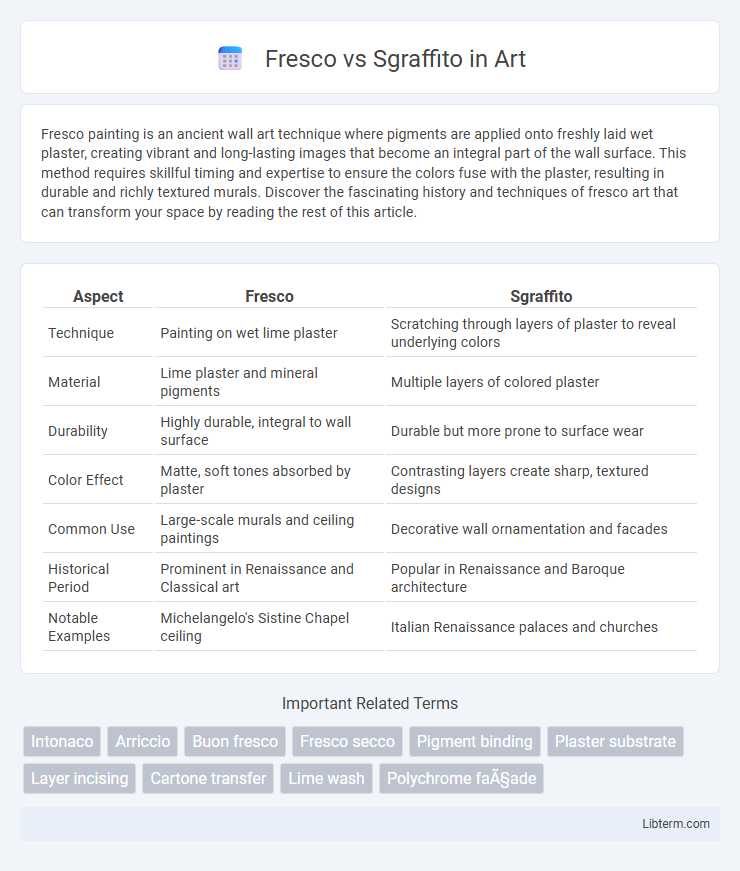Fresco painting is an ancient wall art technique where pigments are applied onto freshly laid wet plaster, creating vibrant and long-lasting images that become an integral part of the wall surface. This method requires skillful timing and expertise to ensure the colors fuse with the plaster, resulting in durable and richly textured murals. Discover the fascinating history and techniques of fresco art that can transform your space by reading the rest of this article.
Table of Comparison
| Aspect | Fresco | Sgraffito |
|---|---|---|
| Technique | Painting on wet lime plaster | Scratching through layers of plaster to reveal underlying colors |
| Material | Lime plaster and mineral pigments | Multiple layers of colored plaster |
| Durability | Highly durable, integral to wall surface | Durable but more prone to surface wear |
| Color Effect | Matte, soft tones absorbed by plaster | Contrasting layers create sharp, textured designs |
| Common Use | Large-scale murals and ceiling paintings | Decorative wall ornamentation and facades |
| Historical Period | Prominent in Renaissance and Classical art | Popular in Renaissance and Baroque architecture |
| Notable Examples | Michelangelo's Sistine Chapel ceiling | Italian Renaissance palaces and churches |
Understanding Fresco: Definition and History
Fresco is a mural painting technique where pigments are applied onto freshly laid wet lime plaster, allowing the colors to become an integral part of the wall surface as it dries. Originating in ancient civilizations such as Minoan Crete and flourishing during the Italian Renaissance, frescoes are renowned for their durability and vibrant hues. Unlike sgraffito, which involves scratching through layers to reveal colors beneath, fresco emphasizes the chemical bonding of pigments with plaster for long-lasting artistic expression.
What is Sgraffito? An Overview
Sgraffito is a decorative technique involving scratching through a surface layer of plaster or paint to reveal a contrasting color beneath, creating intricate designs or patterns. This method has historical roots in Renaissance architecture and is often used on walls or ceramics to add textured visual interest. Unlike fresco, which involves applying pigment onto wet plaster, sgraffito focuses on layering and carving to achieve its distinct artistic effect.
Key Differences Between Fresco and Sgraffito
Fresco involves applying pigment to wet lime plaster, creating a durable and integrated wall painting as the colors chemically bond with the plaster during drying. Sgraffito is a decorative technique where multiple plaster layers of contrasting colors are applied and then selectively scratched to reveal underlying colors, emphasizing texture and pattern. Key differences include fresco's focus on painting within a single wet plaster layer for color fusion, while sgraffito relies on layered plaster scratching for visual contrast and relief effects.
Techniques and Materials Used in Fresco
Fresco involves applying pigment onto freshly laid wet lime plaster, allowing the paint to become an integral part of the wall surface through chemical carbonation, which enhances durability and vibrancy. Materials used in fresco include lime plaster (intonaco), natural mineral pigments mixed with water, and a rough underlayer called arriccio for adhesion. In contrast, sgraffito employs a technique of scratching through a top layer of colored plaster to reveal a different colored layer beneath, relying more on surface texture rather than pigment absorption.
Sgraffito Artistic Methods Explained
Sgraffito is an artistic technique involving scratching through a surface layer to reveal a contrasting color beneath, often used in wall decorations and ceramics. This method typically employs layers of colored plaster or slip, where the artist scratches intricate designs to create detailed textures and patterns. Compared to fresco, which involves painting on wet plaster, sgraffito emphasizes texture and tonal contrast through incised lines and layered materials.
Famous Fresco Artworks and Their Impact
Famous fresco artworks such as Michelangelo's Sistine Chapel ceiling and Giotto's Scrovegni Chapel frescoes revolutionized Renaissance art with their vivid storytelling and durability. These monumental frescoes influenced Western art by establishing narrative techniques and large-scale compositions that inspired countless artists and movements. In contrast, sgraffito, though impactful in decorative architecture, did not achieve the widespread narrative prominence and artistic innovation seen in fresco masterpieces.
Notable Sgraffito Examples in Architecture
Notable sgraffito examples in architecture include the Renaissance-era facades of Krakow's Old Town, where intricate layers of contrasting plaster create elaborate patterns and figures. The Palazzo Massimo alle Colonne in Rome showcases sgraffito techniques with detailed ornamental designs that emphasize texture and depth on its exterior walls. These works contrast with fresco murals, which involve painting on wet plaster, as sgraffito reveals underlying layers by scratching through surface coatings to expose different colors beneath.
Durability and Longevity: Fresco vs Sgraffito
Fresco techniques, involving pigment applied onto wet lime plaster, offer exceptional durability as the paint chemically bonds with the wall, making the artwork resistant to moisture and environmental degradation over centuries. Sgraffito, created by scratching through layers of colored plaster, provides surface texture but is generally less durable due to its exposure and vulnerability to chipping or erosion. Historic frescoes, such as those in Pompeii, demonstrate long-lasting preservation, whereas sgraffito often requires more frequent maintenance to maintain its visual integrity.
Modern Applications of Fresco and Sgraffito
Modern applications of fresco emphasize durability and eco-friendliness, making it a preferred technique for sustainable architectural murals and restoration projects. Sgraffito finds contemporary use in decorative facades and interior design, leveraging its tactile texture to create visually dynamic surfaces. Both methods benefit from advancements in materials, enhancing their longevity and adaptability to modern aesthetic trends.
Choosing Between Fresco and Sgraffito for Your Project
Choosing between fresco and sgraffito for your project depends on the desired texture and durability; fresco involves applying pigment onto wet plaster for vibrant, long-lasting murals, while sgraffito features layering and scratching through plaster to reveal contrasting colors beneath. Fresco offers excellent color retention under proper conditions, making it ideal for large-scale, permanent wall paintings. Sgraffito provides a tactile, decorative effect suitable for architectural surfaces where intricate patterns and relief textures are preferred.
Fresco Infographic

 libterm.com
libterm.com